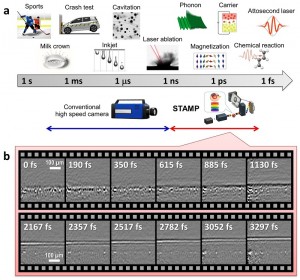World’s fastest burst-mode camera Shooting movies at over 1 trillion frames per second

High-speed photography opens doors to new scientific discoveries by uncovering dynamics hidden within short time windows. However, the speed of conventional high-speed cameras is limited by the processing power of mechanical and electrical components. The pump-probe method, the existing gold-standard for imaging with fine time resolution, requires that events be reproducible for repetitive measurements. Therefore, conventional methods cannot be used to capture complex, non-repetitive, dynamic events on time scales of less than 1 nanosecond.

a © 2014 Keiichi Nakagawa., b Adapted by permission from Macmillan Publishers Ltd: Nature Photonics 10.1038/nphoton.2014.163, copyright 2014
a, Time scale of dynamic phenomena. The speed of conventional high-speed cameras is limited by the processing power of mechanical and electrical components. In contrast, the STAMP camera enables real-time visualization of fast events in which conventional technology falls short. This technique is expected to become a powerful tool for studying a diverse range of complex dynamical processes.
b, Observation of electronic motion and atomic lattice vibrations with STAMP. Lattice vibrations and electronic motion were excited in the horizontal direction. Then, the atomic lattice vibration pulse was formed gradually (upper panel). The pulse propagated in the upper direction at the speed of about one sixth of the speed of light (lower panel). Both motion pictures were acquired by a STAMP camera with an average frame rate of 4.37 trillion frames per second.
Now, research fellow Keiichi Nakagawa (The University of Tokyo / Japan Society for the Promotion of Science), Professor Ichiro Sakuma (The University of Tokyo), Professor Fumihiko Kannari (Keio University), Professor Keisuke Goda (The University of Tokyo / University of California, Los Angeles) and their colleagues have developed a new motion picture camera that obtains continuous, single-shot, burst-type images without the need for repetitive measurements. This new method, STAMP (Sequentially Timed All-optical Mapping Photography), allows for movie shooting at 1 trillion frames per second (fps) and higher and has set a new world record in burst-mode imaging (ultrahigh movie shooting, but with a limited number of frames). STAMP is based on the all-optical mapping of the target’s spatial profile over time onto a burst-stream of photographs. In the lab, STAMP has been used for the real-time visualization of ultrafast dynamic events such as laser ablation (at one frame per 15.3 picoseconds, equivalent to 65.4 billion fps) and phonon dynamics (at one frame per 812 femtoseconds, equivalent to 1.23 trillion fps, and at one frame per 229 femtoseconds, equivalent to 4.37 trillion fps). This is the first time that such ultrafast phonon dynamics has been observed in real time by single-shot imaging (filming in one take).
“This is the world’s fastest camera in burst mode,” said first author Nakagawa, who conducted the research as a graduate student. He added “Our camera is useful for imaging of all kinds of fast phenomena that have been difficult to see with conventional cameras.”
The STAMP camera is available for both macroscopic and microscopic imaging, and can capture with single-shot imaging ultrafast phenomena that take place one the pico- and femtosecond scale which are inaccessible with conventional methods. STAMP holds great promise in terms of practical utility for studying and optimizing a diverse range of complex dynamical processes in photochemistry, plasma physics, condensed matter physics (such as movement of heat, spin and light through materials), semiconductor physics, and ultrasound therapy. “We are currently trying with the camera to tackle a variety of unsolved problems in science and medicine,” said Goda, who supervised the research together with Sakuma and Kannari.
Press release [PDF]
Paper
Keiichi Nakagawa, Atsushi Iwasaki, Yu Oishi, Ryoichi Horisaki, Akira Tsukamoto, Aoi Nakamura, Kenichi Hirosawa, Hongen Liao, Takashi Ushida, Keisuke Goda, Fumihiko Kannari & Ichiro Sakuma,
“Sequentially timed all-optical mapping photography (STAMP)” ,
Nature Photonics Online Edition: 2014/8/11 (Japan time), doi: 10.1038/nphoton.2014.163.
Article link (Publication, UTokyo Repository)
Links
Goda Lab, Department of Chemistry, Graduate School of Science







